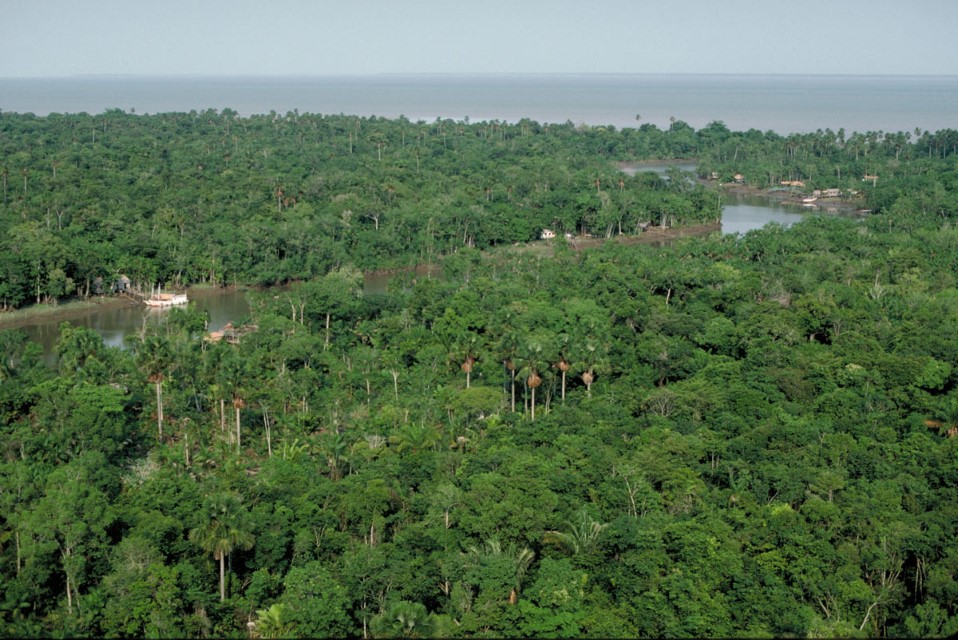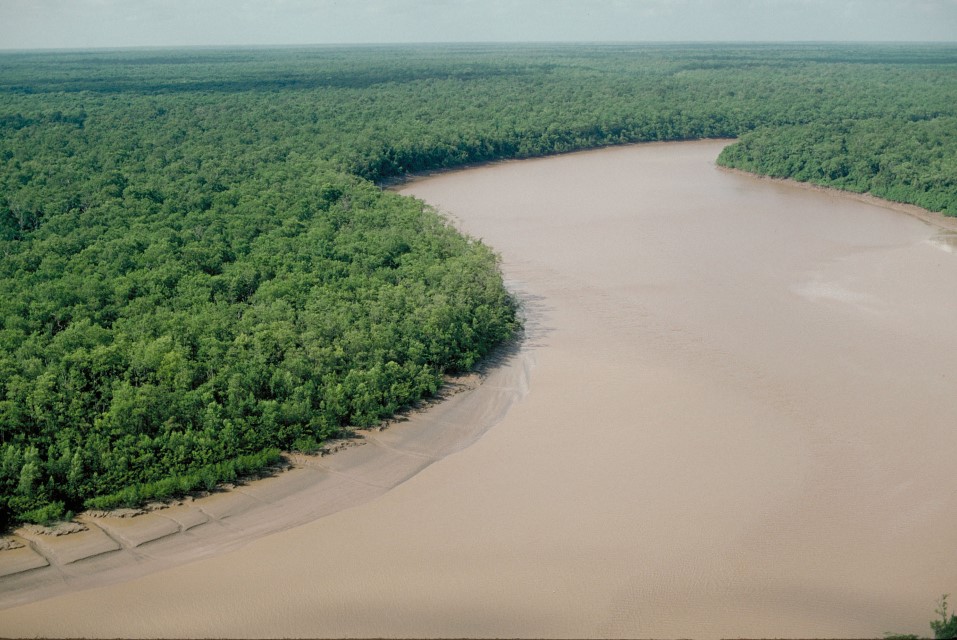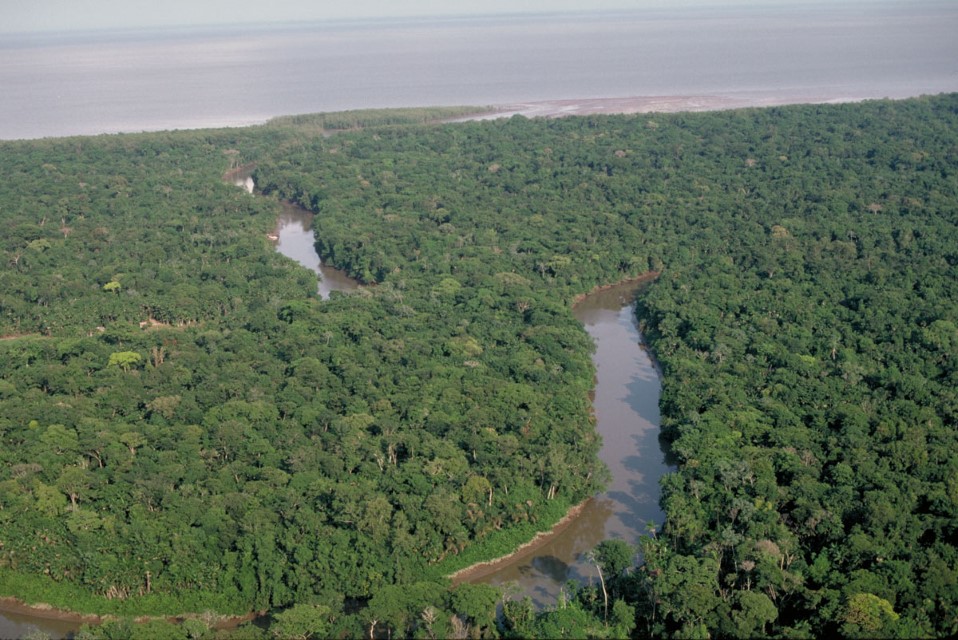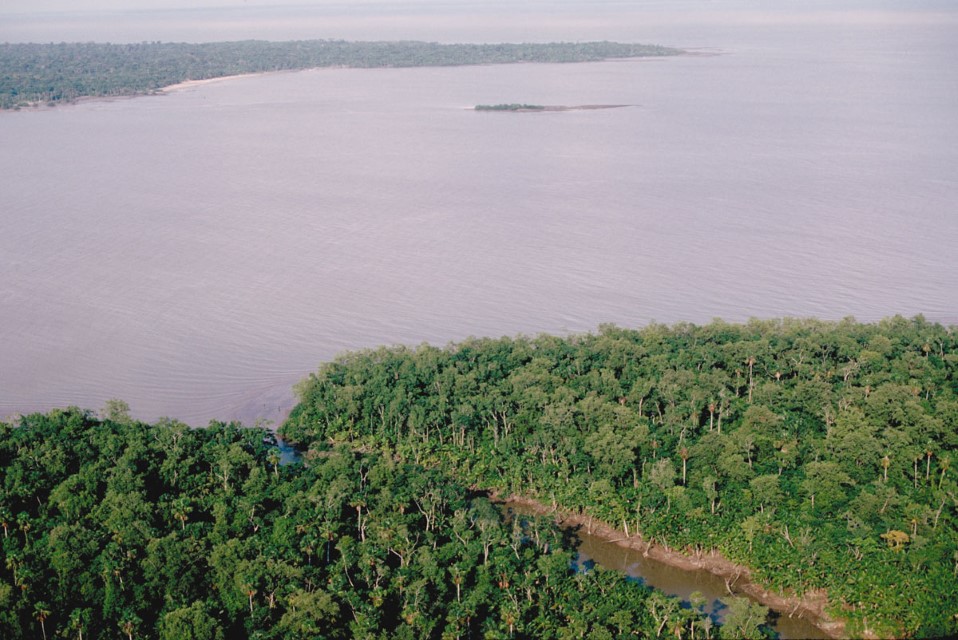The Amazon’s major tidal wetlands include open waters, forests, intertidal mud and sand flats and marshes. The Amazon estuary and coastal region, where freshwater or brackish water dominates, have large expanses of wetland forests. Because most of the region is fresh water, the majority of tidal forests have largely the same tree species found farther upstream in seasonally flooded forest. Where waters are brackish at least during a few months of the year, mangroves dominate. There is also a relatively small transition zone where mangrove and freshwater flooded forest are often mixed. Coastal forests of all types are inundated twice daily by the tides. The spring tides occur twice monthly around new and full moon and result in greater flooding of the islands.
Large parts of the giant Marajó Island, especially its western half, are also inundated by the tides. Palm-dominated tidal forests occur inland out of the reach of brackish water and are common, for example, on the islands near Belém and along the lower Tocantins River, as well as in the some of the archipelagos surrounding Marajó Island. Mangrove forests are most abundant along the Amapá coast and the wide mouth of the Marajó Bay to the east of the Maranhão coast.
Tidal mud flats are major habitats thanks to the huge sediment load the Amazon River deposits in the estuary as a results of the current-braking effect of the Atlantic Ocean. Many are colonized by giant aroids of the genus Montrichardia. The mud flats provide habitat for many aquatic and semi-aquatic animals, including numerous wading birds such as the spectacular scarlet ibis. Although most of the shores in the Amazon estuary are covered by mud, there are also sandy beaches, especially in the Marajó Bay area. The clearwater Tocantins River discharges into the Pará River which then enters Marajó Bay, and fine sand is transported along this route and deposited on beaches that are not covered by mud. There are also alluvial flats in this region with relatively thick deposits of clays, which are mined for bricks and pottery. Sandy dunes are found along northern Marajó Island and their origin appears to be sand that the Atlantic South Equatorial Current carries northeast from the area just outside Marajó Bay. Rocky shores of any extent within the estuary are only found along shores of Marajó Bay, especially along Marajó Island. The rock is locally called canga, and is derived from laterite, soils rich in iron and aluminum.
-

Humedales de mareas 01
Freshwater tidal forest of the Amazon Estuary heavily dominated by palms. Department – Country: Pará – Brazil Main Basin – Sub Basin: Estuary – South Amazon Estuary Elevation: 10 Photographer: Michael Goulding
-

Humedales de mareas 01b
Amazon River at its mouth. Department – Country: Amapá – Brazil Main Basin – Sub Basin: North Amazon Estuary – North Amazon Estuary
-

Humedales de mareas 02
Extensive sediment deposits near the mouth of the Amazon River form large mudflats that are abutted by freshwater tidal forest. Department – Country: Pará – Brazil Main Basin – Sub Basin: Estuary – South Amazon Estuary Elevation: 3 Photographer: Michael Goulding
-

Humedales de mareas 03
Amazon estuary near Belem with tidal forest in the background. Department – Country: Pará – Brazil Main Basin – Sub Basin: Amazon Main Stem – Eastern Amazon Main Stem Photographer: Michael Goulding
-

Humedales de mareas 04
Estuarine tidal forest consisted of both mangrove and freshwater species along Marajo Bay. Department – Country: Pará – Brazil Main Basin – Sub Basin: Estuary – South Amazon Estuary Elevation: 19 Photographer: Michael Goulding
-

Humedales de mareas 05
Tidal forest island of the Amazon estuary near Belem. Department – Country: Pará – Brazil Main Basin – Sub Basin: Estuary – South Amazon Estuary Photographer: Michael Goulding
-

Humedales de mareas 06
Mangrove along the Amapá coast just north of the Amazon River mouth that indicates a mixture of fresh and salt water. Department – Country: Amapá – Brazil Main Basin – Sub Basin: North Coast Basins – Araguari Elevation: 14 Photographer: Michael Goulding
-

Humedales de mareas 07
The estuary near where Marajó Bay meets the Atlantic. During the Amazon River’s high water period freshwater extends out of Marajó Bay and along the Atlantic coast. Department – Country: Pará – Brazil Main Basin – Sub Basin: Estuary – South Amazon Estuary Elevation: 19 Photographer: Michael Goulding
-

Humedales de mareas 08
Tidal forest of islands of the Pará River. Department – Country: Pará – Brazil Main Basin – Sub Basin: Estuary – South Amazon Estuary Elevation: 10 Photographer: Michael Goulding
-

Humedales de mareas 09
Tidal forest along islands of the Pará River. Department – Country: Pará – Brazil Main Basin – Sub Basin: Estuary – South Amazon Estuary Elevation: 10 Photographer: Michael Goulding
